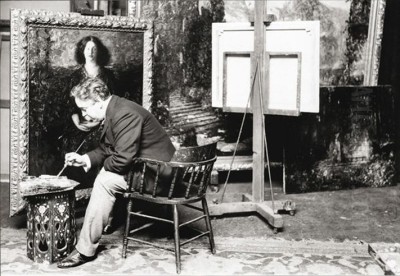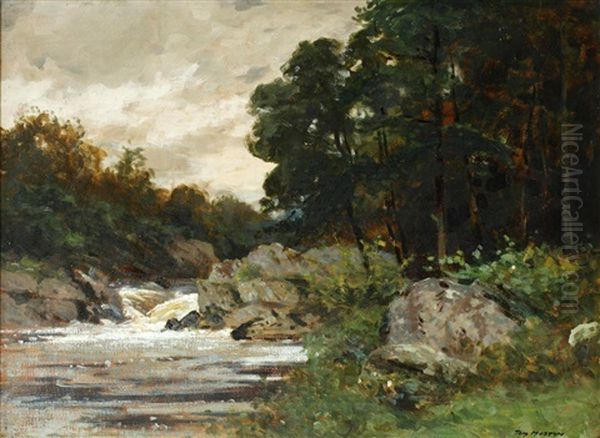
Thomas Edwin Mostyn (1864-1930) stands as a notable figure in British art, primarily celebrated for his enchanting and romantic depictions of garden scenes, which became his hallmark in the later part of his career. Born in Liverpool in 1864, Mostyn spent his formative years in Manchester, a city that would shape his early artistic inclinations. His journey as an artist was marked by a significant evolution in style, moving from socially conscious realism to a highly idealized and atmospheric form of romanticism. This transition reflects not only his personal artistic development but also broader shifts in cultural moods, particularly in the wake of the First World War.
Early Life and Artistic Formation
Mostyn's artistic education commenced at the Manchester School of Art. During this crucial period, he came under the tutelage of Sir Hubert von Herkomer (1849-1914), a prominent and versatile artist known for his social realist paintings, portraits, and pioneering work in printmaking and even filmmaking. Herkomer's influence on the young Mostyn was profound, particularly evident in the themes and style that characterized Mostyn's early output. Herkomer's own engagement with the conditions of the working class and social issues undoubtedly steered Mostyn towards similar subjects.
The training at the Manchester School of Art, combined with Herkomer's mentorship, provided Mostyn with a solid technical foundation. This grounding in academic principles and realist observation would serve him throughout his career, even as his thematic focus and stylistic approach underwent dramatic changes. His early life in the industrial heartland of Manchester likely also provided firsthand exposure to the social realities he would initially choose to depict.
Embracing Social Realism

Following the path suggested by his mentor, Herkomer, Mostyn's early works delved into the realm of social realism. He turned his attention to the lives of the working class, often portraying scenes of poverty and hardship. This phase of his career aligned him with a broader movement in late Victorian art, where artists sought to shed light on the often-overlooked or grim realities of industrial society. Figures like Luke Fildes (1843-1927), known for works like "Applicants for Admission to a Casual Ward," and Frank Holl (1845-1888), who also depicted scenes of contemporary social concern, were part of this artistic milieu.
Mostyn's contributions to this genre included works exhibited at the prestigious Royal Academy (RA) in London. Paintings such as The Torrent (shown at the RA in 1895) and Doss-house (RA 1905) are indicative of this period. These works aimed to evoke empathy and raise awareness about the conditions faced by the less fortunate. They demonstrated his technical skill in realistic representation and his ability to convey narrative and emotion through his compositions, albeit with a focus far removed from the idyllic scenes that would later define his reputation.
A Profound Artistic Transformation
The period following the First World War witnessed a significant and defining shift in Thomas Mostyn's artistic direction. Moving away from the social realism that marked his early career, he began to explore themes and styles that were radically different. This transformation led him to the subject matter for which he is most renowned today: the romantic, idealized garden landscape. The stark realities of industrial life and poverty gave way to dreamlike visions of natural beauty and tranquility.
This change was not merely a stylistic whim; it likely reflected a broader cultural desire for escapism and beauty in the aftermath of the devastating conflict. The war had irrevocably altered the social and psychological landscape, and many artists sought solace and inspiration in subjects far removed from the harshness of modern life. Mostyn found his new voice in the depiction of lush, vibrant gardens, often bathed in ethereal light and imbued with a sense of peace and timelessness. This marked a deliberate turn towards romanticism and idealism.
The Signature Garden Paintings
Mostyn's garden paintings became his signature style and cemented his reputation. These works are characterized by their vibrant palettes, dramatic use of light and shadow, and an almost mystical atmosphere. He often depicted opulent gardens, filled with blooming flowers, verdant foliage, and sometimes featuring elegant figures seemingly lost in contemplation or quiet enjoyment of their surroundings. These scenes were not intended as literal representations but as idealized, poetic interpretations of nature.

Works like The Garden of Peace exemplify this phase, capturing a sense of serenity and escape. Other notable titles include Gather Ye Rosebuds While Ye May, which evokes a sense of fleeting beauty and romantic sentiment, and Elegant Figures in an Evening Garden, showcasing his skill in rendering atmosphere and the interplay of natural and artificial light. His large landscape Peaceful Vision further underscores his commitment to portraying nature as a source of solace and spiritual upliftment.
These garden scenes were executed with a distinctive technique, often involving rich impasto and bold brushwork to convey the texture and vibrancy of flowers and foliage. The overall effect was one of abundance and enchantment, transporting the viewer to a world untouched by strife or modernity. It is this body of work that led to his paintings being affectionately described by some as depicting "God's back garden," a testament to their idyllic and almost divine quality.
Light, Colour, and Atmosphere
A key element of Mostyn's later style was his masterful handling of light and colour to create mood and atmosphere. His garden scenes are often suffused with a luminous quality, whether depicting the bright sunlight filtering through leaves, the soft glow of twilight, or the dramatic effects of sunset. He employed a rich and often intense colour palette, using contrasting hues to enhance the vibrancy and emotional impact of his compositions. This focus on the effects of light and the expressive potential of colour drew comparisons, at least in spirit, to the work of the French Impressionists.
While the provided information suggests an influence or parallel with Impressionists like Claude Monet (1840-1926) and Pierre-Auguste Renoir (1841-1919), particularly in their exploration of light, Mostyn's approach remained distinct. His work retained a strong narrative and romantic sensibility that differed from the Impressionists' primary focus on capturing fleeting moments of perception. His use of colour, sometimes bold and almost non-naturalistic, aimed more at creating an emotional or dreamlike state than at objective representation. This bold colour use might be loosely compared to contemporaries like Frank Brangwyn (1867-1956), who was also known for his rich palettes, though in different contexts.
Mostyn's ability to manipulate light and colour allowed him to imbue his garden scenes with a powerful sense of poetry and mystery. Shadows are deep and suggestive, while highlights gleam with an almost supernatural intensity. This skillful orchestration of visual elements is central to the enduring appeal of his most famous works, creating immersive environments that invite contemplation and emotional response.
Artistic Influences and Contemporaries
Thomas Mostyn's artistic journey reflects a dialogue with various influences and the broader context of British art during his lifetime. The early, decisive influence of Sir Hubert von Herkomer shaped his realist phase. Later, his engagement with light and colour, as seen in his garden paintings, suggests an awareness of developments in French Impressionism, particularly the work of Monet and Renoir, even if his style remained uniquely his own and rooted in a more romantic tradition.
Comparisons are sometimes drawn to the Pre-Raphaelite Brotherhood, particularly in terms of a shared romantic sensibility and interest in evocative themes. However, Mostyn's style diverged significantly from the detailed, meticulous realism of painters like Dante Gabriel Rossetti (1828-1882) or John Everett Millais (1829-1896). Mostyn's brushwork was generally looser, and his focus was more on atmosphere and idealized nature than the literary, historical, or medieval subjects often favoured by the Pre-Raphaelites. Importantly, the provided source material indicates no direct collaboration or documented competitive relationship between Mostyn and the Pre-Raphaelites.
Mostyn worked during a period rich with diverse artistic talents in Britain. His contemporaries included landscape painters like Alfred East (1844-1913), figure painters engaging with rural life such as George Clausen (1852-1944), and proponents of British Impressionism like Philip Wilson Steer (1860-1942). While distinct from the society portraiture of John Singer Sargent (1856-1925), Mostyn shared the era's interest in capturing beauty, albeit through the lens of idealized nature rather than high society. His unique path positioned him as a distinctive voice within this varied artistic landscape.
Exhibition Career and Critical Reception
Mostyn achieved considerable recognition during his career, exhibiting his work regularly and prominently. He frequently showed paintings at the Royal Academy in London, a key venue for artists seeking establishment recognition. His submissions spanned both his early realist phase (The Torrent in 1895, The Dreamers in 1897, Doss-house in 1905) and his later, more famous garden scenes. This consistent presence at the RA indicates a sustained level of professional success and acceptance within the mainstream art world.
Furthermore, Mostyn held several solo exhibitions at the prestigious Fine Art Society in London. Securing solo shows at such a respected gallery was a significant achievement, allowing him to present a cohesive body of work directly to collectors and the public. These exhibitions undoubtedly played a crucial role in building his reputation, particularly for the romantic garden paintings that became his specialty after the First World War.
Despite his success and popularity, Mostyn's distinctive later style was not without its critics. The provided information notes that his work was sometimes controversially described as containing "fairies in paint." This critique likely pointed to the highly idealized, dreamlike, and perhaps perceived sentimentality of his garden scenes, suggesting they departed too far from reality for some tastes. However, Mostyn remained committed to his personal vision, refusing to simply conform to prevailing contemporary aesthetic standards or critical expectations. This artistic independence is a notable aspect of his career.
Later Years and Enduring Legacy
In his later life, Thomas Mostyn resided in London and subsequently moved to Torquay, a coastal town in Devon known for its pleasant climate and scenic beauty, which perhaps resonated with his artistic sensibilities. He continued to paint until his death on August 22, 1930. His passing marked the end of a career that had navigated significant shifts in style and subject matter, leaving behind a substantial body of work.
Mostyn's enduring legacy rests primarily on his post-WWI garden paintings. These works continue to captivate audiences with their lush beauty, vibrant colour, and evocative atmosphere. They represent a particular form of romantic escapism, offering idyllic visions that contrast sharply with the complexities and anxieties of the modern era in which they were created. His ability to blend observational skills with a powerful imaginative and romantic impulse resulted in a unique and recognizable style.
While his early social realist works connect him to important late Victorian concerns, it is the enchanted gardens that define his place in British art history. He remains celebrated as a painter who masterfully captured an idealized, almost spiritual vision of nature, creating immersive and emotionally resonant images that continue to find appreciation among collectors and art lovers today. His journey from depicting urban poverty to creating dreamlike natural sanctuaries highlights a fascinating artistic evolution.
Conclusion
Thomas Edwin Mostyn's career presents a compelling narrative of artistic change. Initially grounded in the social realism promoted by his mentor, Sir Hubert von Herkomer, he produced works addressing the hardships of working-class life. However, the transformative experiences of the early 20th century, particularly the First World War, seem to have prompted a profound shift towards a deeply romantic and idealized style.
His subsequent focus on lush, atmospheric garden scenes, rendered with vibrant colour and a masterful handling of light, became his defining contribution. These paintings, though sometimes met with critical reservations about their perceived fantasy, achieved significant popularity and established Mostyn as a unique voice in British art. Exhibiting regularly at the Royal Academy and the Fine Art Society, he carved out a distinct niche, celebrated for his ability to evoke peace, beauty, and enchantment through his distinctive visions of idealized nature. Thomas Mostyn remains remembered as the painter of "God's back garden," an artist who offered a radiant, poetic counterpoint to the realities of his time.